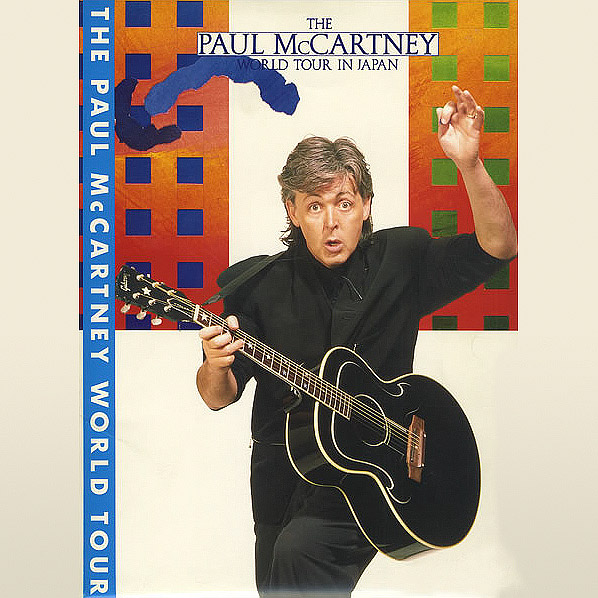Designing the stage sets for “The Paul McCartney World Tour”

- Timeline More from year 1989
About
From Work | Brian Clarke: architectural artist, stained glass artist and painter:
“Ephemeral in their dimensions of time, space and sound, mobile in venues as far afield as Wembley, Tokyo and Rio de Janeiro, made under direction by a team of painters in hired studios, these rolled translucent canvasses, some three stories high, defy the traditional boundaries of stage sets or paintings – they are closer to a transient and nomadic architecture.” – Norman Foster
Brian Clarke first made his set designs for The Paul McCartney World Tour as scale designs in acrylic and collage, cutting and tearing his signature grid and amorphic elements by hand, with the full-size stage sets executed by set painters, first on canvas and then on acoustically transparent scrim as the show was expanded for larger venues. The tour, McCartney’s first under his own name, played to 2,843,297 people between ’89 and ’90, and promoted the album Flowers in the Dirt, whose cover Clarke had designed in collaboration with Linda McCartney. The paintings were at the time Clarke’s largest ever, superseded a few years later by his world-record-setting painted sets for McCartney’s The New World Tour (1992–93).
“In their first incarnation these drops took the form of four paintings each 34 ft by 18 ft. When the show moved from arena to stadium venues in early 1990 two additional wings were conceived to extend stage left and stage right, each canvas being 54 ft x 54 ft and painted on acoustically transparent scrim. Working with lighting designer Mark Brickman the sets were flooded with varying colours in direct relation to the music. The ‘Arena’ sets were used in the European and first leg of the USA tour and the ‘Stadium’ sets in Japan, South America, and the USA second leg.”
“A dramatic example of the versatility of Brian Clarke’s skill can be found in his execution of the stage sets for Paul McCartney’s world tour. The rock (and folk) concerts of the 60s were multimedia ‘events’, and the interplay of light and sound were inducements to the loss of self in transcendent ecstasy, a modern Dionysian rite. In his world tour (1989-1990) Paul McCartney recreates the concept of the light show, but introduces an architectonic element in the form of the huge stage sets created by Clarke: “The stage design is a first for me. Paul and Linda conceived the whole as a real art event.” The sets, which can be appreciated as independent works, have been designed to function in combination with the virtuosic display of lights. The variation in colour and intensity of light in stained glass, which is normally produced by ambient natural light, is simulated in the sets by projected artificial lights to create what appears to be an infinity of modulations in a stained glass ‘tableau vivant’.” –Paul Beldock in the essay Into Architecture, from the book Brian Clarke: Into and Out of Architecture.
Last updated on December 22, 2023